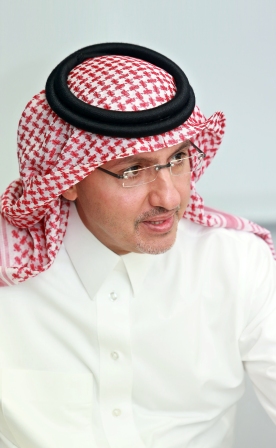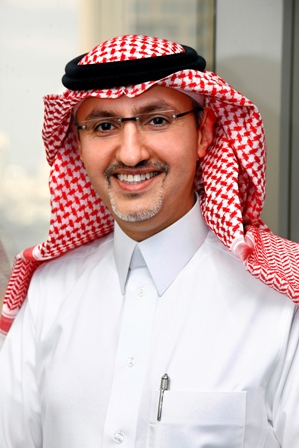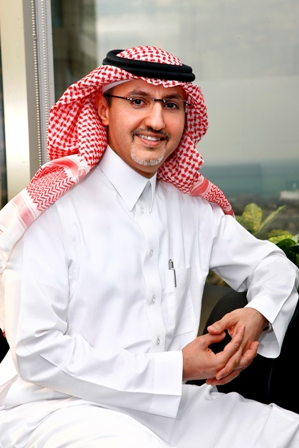In this exclusive interview, Abdulaziz Al-Sowailim, Chairman of EY Middle East and North Africa, speaks to Accountant Middle East on the firm’s global rebranding, nine decades of doing business in the region and why MENA is still a great investment destination.
Q. From July 1 2013, Ernst & Young changed its brand name to EY. Tell us more about the new global brand name and logo.
A. Our brand name has changed to EY. Shortening the name will provide consistency and ease of use for EY practices and clients around the world. We have also redesigned our logo, reflecting our new brand name clearly in the design. Our new brand name and logo demonstrate clearly and boldly who we are and reflect the traits we need to have the best brand in our profession.
What does the new purpose mean?
Our purpose means that EY is committed to doing its part in building a better working world. To us in the region, the message is very clear. Building a better working world is not just about creating a better office environment. It’s about channeling our strong legacy as an organisation and who we are as individuals, working together as a region to achieve sustainable growth and make a positive impact in our communities.
Over the last 90 years EY has been a strong influence in the region, guiding business and working closely with the public sector. It is now up to us to create an even stronger EY for future generations. The insights and quality services we deliver help build trust and confidence in the capital markets and in economies.
We develop outstanding leaders who team to deliver on our promises to all of our stakeholders. In so doing, we play a critical role in building a better working world for our people, for our clients and for our communities. We know that building a better working world is an ambitious objective but it is an incredibly important aspiration and will be front and centre of everything we do as an organisation. We help our clients, our people and our communities one project at a time. Over time, the whole working world works better.
EY has completed 90 years in the Middle East and North Africa (MENA). How would you sum up this incredible journey?
Indeed, this is a milestone year for EY as it marks our 90th anniversary in the Middle East and North Africa. Our first MENA office opened in Iraq in 1923. Now EY is made up of more than 5,000 people in Bahrain, Lebanon, Qatar, Kuwait, Jordan, UAE, Saudi Arabia, Oman, Egypt, Palestine, Syria, Libya, Iraq and Pakistan.
Over the years, generations of EY people have proudly played a major role in helping regional businesses succeed. Today, EY is the largest and most established professional services organisation in the region providing assurance, tax, transaction and advisory services.
We are very proud of our MENA heritage and will continue to prioritise the development of our local communities. We help develop outstanding leaders who deliver exceptional services to our clients and who contribute to our clients and communities. In addition to passing this significant milestone we have had many developments globally too. This year, Mark Weinberger also became our new Global Chairman.
How important is the MENA region to EY?
EY was the first professional services organisation to operate in the region, so we were the first to see potential. Nine decades later, we are still growing and investing in MENA.
Over the last 12 months, 26 partners joined the EY MENA practice. This is a significant addition to our leadership team in the region and is indicative of our ambitious investment and growth plans.
The region is going through challenging socio-political and economic changes and our new partners have a crucial role to play in leading this generation of EY and in helping our clients navigate through these times.
Why is the Middle East a good investment destination for global businesses looking at the emerging markets?
The region is blessed with several attributes that make it an attractive destination for business – solid fundamentals, strong demographics and government willingness to improve the already concrete growth prospects. The region’s large population is one of the youngest and wealthiest in the world.
Vast natural resources combined with steady and robust oil prices have created substantial budget surpluses among oil exporters. This helped many regional governments to increase their spending on infrastructure projects and efficiently drive their diversification efforts.
To sustain this, the region needs to energise its innovation climate. They need to develop coherent links between all stakeholders in the innovation ecosystem such as academics, regulators, entrepreneurs and multinational corporations. As the innovation climate in the region improves, countries will find it easier to pursue economic diversification.
International investors see bigger internal markets, more accessible customers and better transport and logistics infrastructure as some of the most attractive features of the region.
The Middle East with its large market potential, coupled with investment and infrastructure programmes, and abundant natural resources make it a natural choice for consideration by foreign investors. However, challenges remain and the region must improve its technological readiness and regulatory environment, then — with a more stable political environment — it will be better able to compete with the larger rapid-growth markets for investment.
With regards to the direction of inward investments – since 2003, the majority went to the GCC countries of Bahrain, Kuwait, Oman, Qatar, Saudi Arabia and UAE. The bulk of this has gone to the GCC ‘trio’ of UAE, Saudi Arabia and Qatar.
You spoke about the trio GCC members UAE, Saudi Arabia and Qatar. What are the macro economic factors that you think businesses should be bullish about?

“EY was the first professional services organisation to operate in the region, so we were the first to see potential. Nine decades later, we are still growing and investing in MENA.”
Let’s first look at the region as a whole before we speak about the fastest growing economies in the region. We expect the Middle East region to grow by 3.0% this year, down from growth of 3.7% last year, which partly reflects lower commodity prices. However, the recovery in global trade will boost the region next year, underpinning growth of 4% or more.
Still, our slightly more subdued forecast for activity in China will reduce demand for Middle Eastern exports a little in the medium term.
But in the key Rapid Growth Markets like Saudi Arabia, UAE and Qatar, a young population is helping to foster entrepreneurship and the growth of the non-oil sector is buoyant, protecting these economies from slower global oil demand.
How do you think Saudi Arabia will do?
We expect the Saudi economy to grow by 4.3% this year and 4.6% in 2014 — a slowdown from the 6.8% growth achieved in 2012. This slowdown largely reflects lower oil production.
A dip in Saudi production compared with recent years reflects a number of factors, including higher supply from Libya, Iraq and North America, as well as relatively weak oil prices. In contrast to developments in the oil sector, non-oil growth will remain robust in the next few years. Consumer spending will grow strongly, buoyed by fast growth in retail lending and a falling unemployment rate, particularly for males.
Meanwhile, fiscal policy will remain supportive, with government spending forecast to rise by an average of 7.4% per annum between 2014 –16. We expect growth to average 4.5% per annum in the medium term, supported by strong fundamentals. But there are a number of downside risks to our forecast. On the oil front, the development of shale oil and gas in the US and rising supplies elsewhere threaten to limit potential oil output in a sustained way.
Qatar is one of the fastest growing economies in the world and is seeing a surge of infrastructure activity. What are your projections for the country?
Qatar is seeing a lot of fast paced activity. Our growth forecast is at 5% this year and 6% in 2014.
The growth was concentrated in manufacturing, construction and government services. These sectors will likely continue to be the main drivers of activity, with the hydrocarbon sector broadly flat.
Growth will be driven by a rise in the non-oil sector. More specifically, construction, transport and communications, trade and hotels, and government services will lead the way as the Government implements its huge infrastructure plans. This is driven by its planned hosting of the 2022 FIFA World Cup and also by an expanding population.
Hamad International Airport is set to open soon and the first contracts for a $36 billion rail system are due to be signed. The 2013–14 budget shows spending up 18% on 2012–13 plans.
There will be no additional gas export capacity until at least 2015 and we do not expect any rise in oil production this year. This reflects marginal spare capacity and no pressure to add to supply, because of added supplies elsewhere and potential price weakness. After posting double-digit rates in 2006–11, we expect GDP growth of around 6% over the medium term in Qatar.
What about the United Arab Emirates?
Growth in the UAE will remain robust in the medium term, averaging 3.9% between 2013 and 2016. Several factors will drive this, including broad-based recovery across key sectors (such as financial services and construction), where performance since the financial crisis has been underwhelming. Fiscal policy will remain accommodative in both Dubai and Abu Dhabi, with several infrastructure projects in the pipeline.
A generally brighter global outlook in 2013–14 and beyond will also benefit Dubai in particular, which accounts for 75% of the UAE’s non-oil trade. Risks to our forecast are broadly balanced. Higher oil prices and safe-haven capital flows arising from instability elsewhere in the region could lead to a surprise on the upside.
Which sectors do you think are flourishing in the GCC?
Despite traditionally being seen as part of a region famous for its vast natural resources, the GCC countries have used the surplus cash to diversify into other sectors. The first half of 2012 continued to see increased diversity in the sectors attracting FDI in the Middle East.
Retail and consumer products attracted over 20% of projects in the first half of 2012 and – along with business services, real estate, hospitality and construction – became a top choice for investors. The retail sector is capitalising on the region’s rich and expanding consumer base.
Real estate has seen a revival in 2012 and attracted the most capital investment. Most regional governments are recognising their citizen’s social infrastructure needs. In addition to massive outlays to respond to this — and the announcement of ambitious projects like the 2022 FIFA World Cup — the prospect for the infrastructure sector seems promising.
The business services sector is also becoming increasingly popular among investors and ranked second in terms of projects and third in terms of value. This sector draws strength from the presence of free trade zones.
Established investors see real estate and construction as the most promising growth sector for the future. More opportunities are also emerging in the private and business services sector, real estate, hospitality and construction, information and communications technology and life sciences sectors.
Do you think markets share this optimism?

“We are very proud of our MENA heritage and will continue to prioritise the development of our local communities.”
Absolutely. Look at the way deals in the region are shaping up. The MENA value of disclosed inbound deals increased by 108% if you compare the first half of 2012 and 2013.
This overall positive improvement of inbound investment could signify a continued level of confidence in the MENA market irrespective of the continued political uncertainty in the region.
The economies that you highlighted are oil majors. What about trade? Will MENA play an important role in trade – like the way it plays a crucial role in the energy mix?
MENA trade flows will grow fastest with Russia, India and China between now and 2020. While advanced economies muddle through the financial crisis, the rapid-growth markets are becoming an increasingly significant part of the global economy. They will become an even more dominant force in global trade and as a result, businesses are going to have to adjust their strategies to reflect the increasingly regional pattern of world trade.
The degree of change in both the scale and direction of trade will have a profound impact on the competitive environment for all companies wherever they are located around the world. Trade will also be increasingly focused around Asia, the Middle East and Africa, suggesting that the key geographical location for companies will change. Indeed, Europe’s exports to Africa and the Middle East are forecast to be around 50% larger than its exports to the US.
New markets for exports are also opening up within MENA and Sub-Saharan Africa as these economies grow in size. Total exports to these regions are forecast to grow more rapidly than exports to the US, Europe, Japan and the rest of the Americas. Richer economies in the region, particularly the oil-exporting economies of the Middle East, will also represent increasingly important sources of final demand for manufactured products.
So how is EY helping organisations manage the profound changes in the region?
By 2050, 600 million people will call the Middle East and North Africa region their home – nearly double today’s population. As the population increases, housing, education and health facilities need to take priority – we are focusing on advising policy makers on the development of social infrastructure.
Women in the region now control $1 trillion of the assets. More people are recognising that gender equality is key to stability and growth. Our strong diversity and inclusiveness initiatives around the world make us the natural leader in this transition.
Even in the resource-rich Gulf, building a sustainable future is key. Through our Climate Change and Sustainability Services and our Cleantech groups, EY has always demonstrated its ability to help address this need for change.
And today, MENA plays its part in the global economy – with over 5,000 of our people, we continue to support MENA’s journey as an emerging market.













